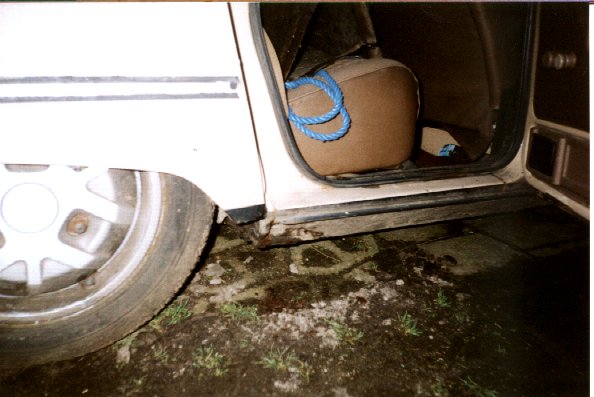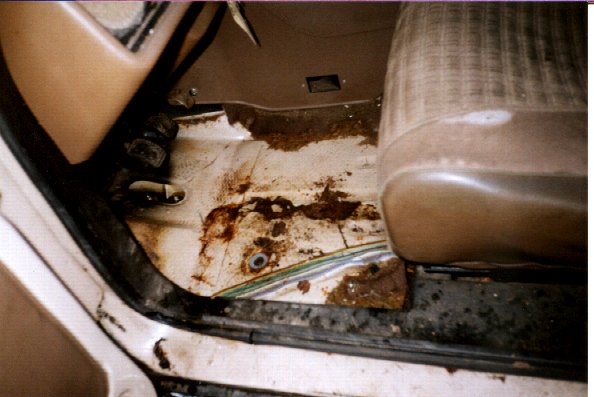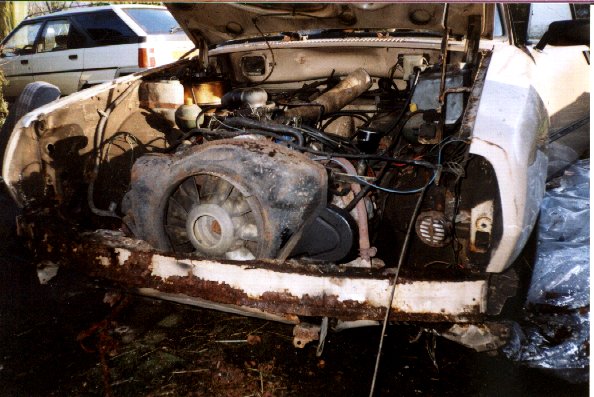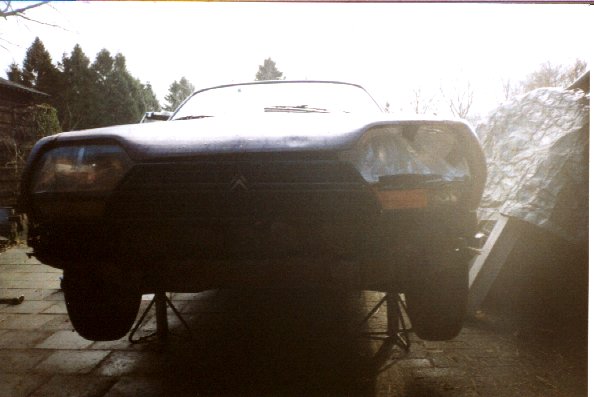Buyersguide
Where to buy a GS/GSA?
If you would like to buy a GS/GSA, there are some ways to try.
- Look in the adds of vintage cars magazines. For example Citropolis, as a magazine devoted to Citroën enthusiasts, has a few advertisements. Note that these cars are usually sold by owners who know the value of their cars, this may reflect in the prices.
- Visit a large Citroën Dealer and ask the senior salesman, you might still have a chance of finding a GS/GSA this way.
- You can do a websearch for GSs/GSAs for sale. A lot of car dealers and garages have they're used car selection online. Also cars from private people are being offered for sale on the web. There are some garages specialised in vintage cars. In Holland, look at the site of the Dutch GS/GSA vereniging, that has a number of adds online.
- The number of GSs/GSAs for sale is of course dependable from the country you live in.
If locally there are not many GSs/GSAs for sale, you can consider to import one from France or
Spain. You can either do it yourself, or talk to a specialised company, the last mentioned costs
more, but saves a lot of paperwork and time. The advantage of French and Spanish cars is that most
of them have better bodywork due to the dryer climate. Cars in the more wet parts of Europe tend
to rust quicker. Although cars from hot climate countries have a more 'sun tainted' interiour.
The purpose of buying a GS/GSA
You can consider a GS/GSA as you're daily car. But be aware that it is an old car and old cars break down now and then.
Even if they're well looked after. A lot of people have a GS/GSA as they're second car, to drive in the summer,
so that the car doesn't get affected by the bad weather in the winter. It should be advised to park the
car in a dry, built over area, that way it wil stay longer in shape then parked outside.
Which GS/GSA to choose?
First of all, many things can be said about construction quality of different types and ages of GS/GSAs.
But since GS/GSAs are becoming rare it is better to look at individual cars then generalise whole series or types of GS/GSAs.
A few considerations. Models anterior to 1973, they can be looked after for their historical interest, but often
many youth problems. The GSAs built between 1984 and 1986 are generally not as good as GSAs built between 1979 and 1983.
For the GS, most agreable are the Pallas, for luxury, and X/X2/X3 for their sporting look and performances (X2/X3).
But then again X/X2 and X3 are more seldom than other models. Look after options as
sliding roof, tinted windows, "Convertisseur/C-Matic" semi-auto transmission, vinyle roof
(accessory) is very rare too, and the sliding rear seat can be useful if you want to use your GS daily.
Avoid 1015cm engines, rare and interesting from historical view point but underpowered and often
problematic. For the GSA, the X3 with its 5 speed gearbox is interesting. Although 5 speed transmissions where also available in other
versions, the X1 and X3 have a more sporty transmission than the other versions.
A GSA X3 in preference with options (alloy wheels, tinted windows, sliding roof) is very nice.
A Pallas is nice too, again for it's luxury. Of course you can build options on you're Club, Special or other model, but beware that not all
parts are easily available. Do not neglect limited editions (GS Basalte, GSA Tuner, GSA Chic
and GSA Cottage Break) as they are very rare. Esspecially a GS Basalte is very worthwhile and can
be considered as a full-option Pallas. Note that these limited editions have special parts,
like striping, special seats, etc. If that has to be renewed, it will not be easy to find and certainly not be cheap.
Prices
Of course prices are dependable on a range of things, like the condition of the car, The country it is sold in,
the type, the kilometers it has driven, the person or garage selling it, etcetera. The overall picture is that
GSs cost more than GSAs and Breaks cost more than Berlines. Also mk1 GSs cost more than mk2 GSs.
It is hard to give exact price indications, since this really depends on a lot of factors.
| Estimate prices GS/GSA in Euros | ||||||
| Type of GS | Condition | |||||
| Restored | Very good | Good | Average | Below average | Wreckage | |
| GS mk1 (1970-1976) | 9000 | 6000 | 3000 | 2000 | 750 | 500 |
| GS mk2 (1976-1979) | 7500 | 5000 | 2500 | 1500 | 750 | 250 |
| GSA (1979-1986) | 5000 | 2500 | 1500 | 500 | 250 | 150 |
| Definition of terms: | |
| Restored: | Aswell body, interiour, electrics and technical the car is as new. All parts used are new or revised. The car is in excellent condition. |
| Very good: | Car has not been restored, but is in a extremly good condition, either many parts are renewed or the car is hardly used (75.000km or less). |
| Good: | Some parts have been renewed, other parts are in good shape, few areas need repairing/replacing. |
| Average: | Few parts are in excellent condition. A lot off parts are used, or in need of reparation/replacing. |
| Below average: | This car has only one or two good points, usually this is a car with a good bodywork or body structure, but other than that worn out. The car can be saved, but it will have to be done imediately. The majority of parts at this car needs replacing. |
| Wreckage: | A car in this condition is beyond saving. It is just not worth time and trouble anymore. Dismantle all good or relatively good parts and bring what is left to the car crusher. |
The 'street value' of a good GS is aproximately 2500 Euro. A GSA costs less, from 2500 Euro for a really good one to virtually nothing for a reasonable one. If you are going to restore a GS/GSA at a specialist, then 7500 to 10000 Euro is a good price indication. If you do the restoration yourself it costs aproximately 3000 to 6000 Euro. Usaully cars need a paint job (esspecially GS), and revision of engine and transmission.
Where to look for by buying a GS/GSA?
Rust. A GS/GSA rusts, this is inevitable. The design of the car, with many hollow sections the
short development time of the car, the poor quality of used steel, as in so many seventies manufactured
French cars are the main reasons for this. Therefor carefully inspect a car at purchasing. The places
to look for are:
- Under the car;
-in front under the driver and passengers seat
-under the rearseat
-the chassis near the sills
-the pipe for the exhaust
-brake and hydraulic lines
-subframe at the rear end, the front end hardly gives problems, since it is usually covered in oil.
-body rusts around suspension subframe attachment points
- Bodywork; look at the following places;
-the underside of the doors
-the front panel underneath the front bumper
-the area around the windscreen
-the trunkcover at GSAs and in all break versions
-the front of the engine hood
-rearpanels around the rearwheels, these are welded to the carroserie and therefor difficult (but possible) to replace
-the bodywork, where the bumpers are attached. This is difficult to spot and therefor can easily be overlooked
-the sides of the reardoors
-the wheelarches, remove the wheel and use a screwdriver tot test the bodywork behind the wheels, if it has sustained damage by rust, the screwdriver goes right through the bodywork
- Inside the car;
-lift the carpets in front of the drivers and passengers seat, inspect the bottom thouroghly
-lift the carpet in the trunk, check the trunk bottom
- Engine compartment;
-Check the batterybox, beneath the battery


Left: Rust in the trunk. Right: Rust at the chassis.


Left: Rust in the bottom, beneath/in front off the drivers seat. Right: Rust underneath the batterybox.


Left: Rust at the lower front panel, at almost all GSs this rusts heavily. Right: Also rust at the lower front panel.
kokerbalken
wieldraagarmen wheelarm /Bearings, triangle trailing arm
wielkasten -wheelarches wishbone
pakkingen casket/casket seals
keerringen seals
nokkenassen camshaft
stuurhuis steering rack
verdelerkappen
dorpels sills
Engine and transmission.
A GS/GSA leaks oil, this is also almost inevitable. Engines and transmissions that do not spill oil
are extremly rare, or revised. This does not mean that the problem is important. Oil leakage can be
considered normal for a car with an age of 15 to 20 years. Oil leakage can be stopped by usage of
better materials or by revising the transmission or engine.
Other than this, the 1222cc, 1129cc and 1299cc engines and gearbox, if they are properly maintained
are very reliable and can easily cover 200.000km. Last but certainly not least, belts driving the camshafts
wear should be replaced every 20.000km, this is very important! Make sure that the belts are on the right
way, get them wrong and the pistons start hitting the valves and there goes you're engine. Further
rubbers used in the engine have the same age as the car, and therefor they will brake now and then.
replacing is usually relatively easily and they cost not too much. Also casket seals and other seals
are usually of the same age as the car and therefor will be in need of replacing.
If the engine makes a "clicking" noise while running, this may indicate a worn out camshaft. This
is repairable, but expensive. A revision of the camshaft is a possibility and costs aproximately
500 Euro.
Hydraulics.
If properly maintained, this shouldn't give any problems. Check if the spheres have enough pressure,
by putting the car in the highest level and look at the indicator underneath the hood. Start the
car and see if it rises smoothly. Drive a bumpy road, if you feel any bumps then the spheres need
replacing or need to be refilled. Spheres should be checked regularly. Check the hydraulic pipes
underneath the car for rust. Pumps can leak but can be overhauled by specialists. Without special
equipment this is almost impossible and the pump could be damaged.
Too frequent clicking of the hydraulic pump indicates that the main hydraulic sphere needs to be renewed
or refilled with LHM, which can be done by any Citroën garage. Renewing is better, since this sphere
handles most of the pressure. In general can be said that the hydraulic system of GS/GSAs is very reliable.
But the rubbers used, are most of the time as old as the car, and therefor there will be one in need
replacing now and then.
Brakes and steering
Check the brake lines for rust. The discbrakes on the rear of the car can get stuck and therefor
wear off unregulary and start to rust. Replacement is a considerable amount of work but parts are
available. If the steer makes a noise by steering, then the steering rack is worn out and needs
to be revised. Check also the rubbers of the steering rack.
Ignition and caburattor
A Weber caburattor is the best for the GS/GSA, the Weber are not very sensitive for dirt.
A solex can be used aswell. For a 1222cc engine a Weber caburattor may be hard to find.
Ignition, Ducelier or SEV. Ducelier is slightly harder to maintain, unless it is an electronily
adjusted one. SEV is less reliable. You should not have many problems finding ignition parts,
enough second hand available.
Tires and fuel usage
GS/GSAs are designed for the usage of Super fuel. However most GS/GSAs can use Euro 95 unleaded
or 98 unleaded without problems. Except for the oldest GS models, who do not have hardened valve
seats! Often the engine needs to be tuned by the change of fuel type.
Use Michelin 145 SR 15 tires, these are specificly designed for Citroën and therefor they
are the best choice. For the GSA alloys wheels, use the Michelin 145 HR 15 tires. If Michelins
are not available you can use other brands.
Other weaknesses
Good bodywork is hard to get these days. And if you do find it, it may cost a lot. The steel
used is not very thick, a dent is easily made. The interiour is not of very high quality, good
seats and dashboards are rare. The electrical installation is reliable, however sometimes there
may be a disturbance, which causes the most odd problems. Alternators are wekaer than average,
but availability of replacements is good. Door- and contactlocks are weak an can be openend with
a coin or a screwdriver.
GS Birotor specific
To cut things short, if you do not have loads of cash, do not buy this car. The Birotor is a really
advanced example of Citroën engineering. But many times more complicated than a standard GS.
So very hard maintainable and parts are extremly hard to find and extremly expensive. Remember
that only 847 Birotors where build, of which most where destroyed. A Birotor in good shape will
cost over 15000 Euro. The engine of the Birotor is not very reliable and is worn out after 60.000km.
However the NSU RO 80 has the same engine as the Birotor, so this may give a lead to more spare parts.
After Sales
Join a Citroën Club, it is not only fun to go to meetings and things like that.
But you can also learn from the experiences from other people. In clubs people
with the same cars are gathered, they can advise you on all sorts of aspects of
driving and owning a GS/GSA. Join a mailinglist on GS/GSA on the internet, this
works the same as with clubs, people share they're expierences and you can
benefit from that. Search a good garage. Nowadays there are not many garages
left who can service you GS/GSA in the right way. Therefor ask around with fellow
owners for a good garage, this can save a considerable amount of money, invested
in bad reparations. And in the worst case, this can even save you're car.
1995-2000
I like to receive e-mail, therefor you are welcome to send me any message for any comments, ideas, questions or additions! I also welcome any contribution! mattysk@dds.nl
